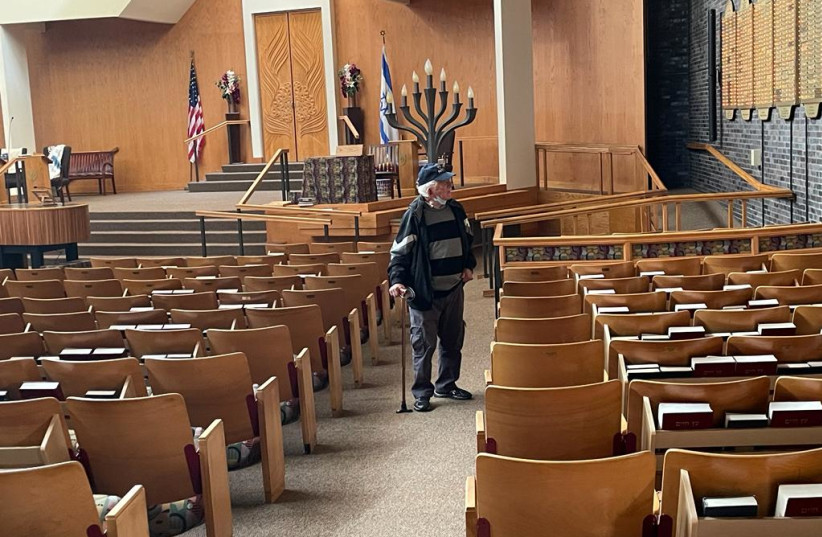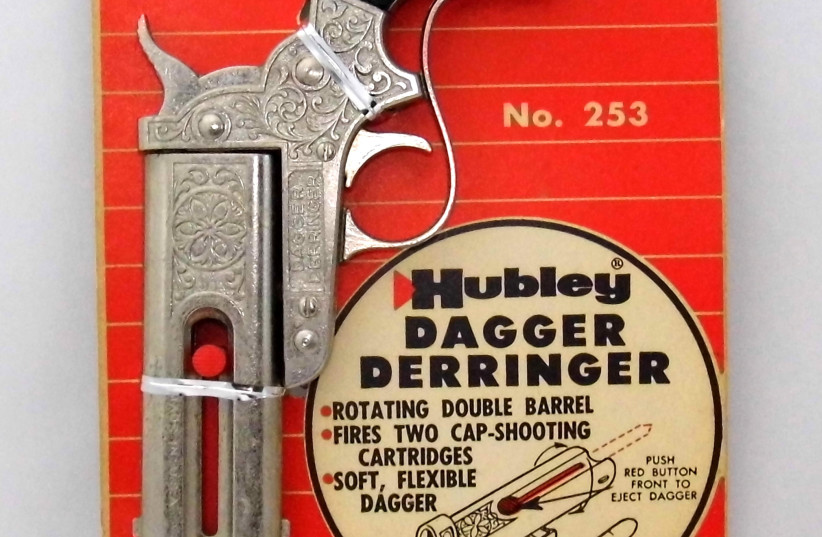Hopefully, we can all recall our first Purim, the annual commemoration of the near destruction of the Jews who were saved by the strength and courage of Queen Esther, our exceptional ancestor.
In Atlanta, where I grew up in the 1940s, we sang “Esther was the lovely queen” with gusto as the girls all dressed up as her. None of us, however, ventured onto the streets of the famed south side, where many of the city’s 40,000 Jews lived. Observing and enjoying the Jewish faith was carried out indoors.
At my synagogue, Shearith Israel, my friends and I had a wonderful time dressing up in costumes for the large Purim party held on the Sunday before Purim. Parents watched joyfully as their kids danced excitedly. A professional dance teacher, who was a synagogue member, choreographed a “Purim square dance,” in which we did Esther and Mordecai formations instead of the typical do-si-do.
Purim at Shearith Israel
The grager (noisemaking device) banging and twirling contest filled the synagogue hall with an inordinate amount of noise. I never used my own unusual grager in the contest – who knows, had I done so I might even have won. Instead, I always wanted it to explode with the sound of thunder as the megillah was read.
The synagogue had a bimah (raised platform) in the center where the Torah was read. I can recall the visiting cantors, whose voices soared beyond the roof to heaven – if they were good. Others, who weren’t so good, screeched – or so it seemed.


Under a cloth carefully carried into the synagogue was my grager, which I held tightly as the megillah reading began, anxiously waiting for the first “Haman.”
Then, the moment of truth. When his name was said, I quickly uncovered my metal bucket and rolling pin and pounded away. The noise was incredible for me, although the rest of the congregation covered their ears. My poor father was so embarrassed. “Der rebbe’s aynikl” (the rabbi’s grandson), people muttered disapprovingly.
I was in my element, however, in my cowboy outfit which turned me into Hopalong Cassidy, not Mordecai HaYehudi. My father grabbed the rolling pin and slapped my hand hard before putting the bucket under my seat.
But I had not finished. I pulled a cap gun out of its holster on my cowboy costume and blazed away, firing caps with reckless abandon. Some of the other boys had cap guns too, and we all fired in unison.
I cherish that Purim night, weaving my “wicked sound” into the main synagogue. Sadly, only a few of us parents and children are left to recall that night.
“The Rebbe wants to make sure that all the American soldiers, men and women, can hear the reading of the megillah.”
A Chabad rabbi from Detroit
Another memorable Purim: Fort Sill, Oklahoma
ANOTHER MEMORABLE Purim for me was at Fort Sill, Oklahoma, where I served as a chaplain during the Vietnam War, from 1965 to 1967.
Two months before Purim, I received a call from a Chabad rabbi from Detroit. “The Rebbe wants to make sure that all the American soldiers, men and women, can hear the reading of the megillah,” he said.
Although very wise, the Rebbe may not have realized there was a town called Lawton next to Fort Sill, where 20 Jewish families already lived. Their presence in the town dated back to the Oklahoma land rush of 1889, when Morris Simpson brought a Torah to the town in his covered wagon.
An extract from an article in The Jerusalem Post explains: “When the Oklahoma land rush occurred in 1889, there were at least two Jews who participated, Morris Simpson and his brother. They brought with them a Torah in their covered wagon.
“When they arrived at their selected plot in Lawton, next to Fort Sill, they set up a dry goods store. After a week or so they put together a synagogue in a tent near the store.”
Five Jewish families moved from Oklahoma City to Lawton in the 1920s and bought burial plots in the Jewish cemetery.
The remainder of the Jews who live there came during World War II from the eastern part of the US. Although they were among at least 250,000 Jews who volunteered to serve, ill health prevented them from doing so.
The venerable Marvin Trope was the chairman of the Lawton Jewish Welfare Board (JWB), the members of which were always helpful to the then 550 Jewish personnel at the largest artillery base in the American army.
Since all of the Jewish residents of Lawton owned clothing stores, hardware stores and fancy shops, the soldiers bought from them on extended credit. As most of the daughters had already married, making a shidduch (match) for them was not so easy.


To help raise the soldiers’ morale, I also worked with the Jewish community center in Dallas, 250 km. away, on social programming. Four times a year, on a Friday, a bus from Dallas carrying 30 girls came to Lawton.
Housing had been arranged for the Friday night at our military synagogue, where we held Shabbat services with a large crowd, including all of the women from Dallas and many of the Jewish soldiers. The women brought kosher cold cuts, pickles and rye bread and cake with them from Dallas.
On Saturday night, a dance was held at the Officer’s Club, arranged by the highest-ranking Jewish officer, Col. Jack Wolfson. On Sunday morning, the girls went home, leaving our soldiers delighted.
RETURNING TO the Chabad call from Detroit, I arranged with their rabbi in charge that he and two others would fly to Oklahoma City on the Thursday before Purim, since the holiday began on Saturday night. We set up beds for them in my chaplain’s office, which was a little building, so they could have some privacy.
They had brought a megillah and a lot of small gifts from the Rebbe: little hamentashen – hard as bricks, tallitot (prayer shawls), a few extra pairs of tefillin and prayer books.
The JWB sent us printed megillot with English translations, candy and gragers. My wife and several of the other women from Lawton, along with the wives of the Fort Sill military doctors, dentists and lawyers, baked hamentashen.
Shabbat services on Friday night and Shabbat morning went well. One of the Chabad rabbis read the “Simpson Torah,” after I assured him that I had it checked in Dallas by a Torah scribe who had been traveling in the southwest.
For the Purim service on Saturday night, we had around 150 soldiers, 40 local families, 18 children in costume and our guests, the Chabad rabbis. It was a wonderful evening – the sounds of whirling gragers, loud boos and soldiers’ boots pounding the floor ensured that the name of Haman was drowned out.
Then treats from the JWB and the Rebbe, along with homemade hamentashen were handed out. My wife and I were in seventh heaven; we were in Oklahoma, ”where the corn grows as high as an elephant’s eye,” and what a Purim we were having.
On Sunday morning, before the Purim party, the Chabad rabbis led the prayer and read the megillah. Some of the soldiers were very moved when they wore tallitot and tefillin.
At around 10 a.m., we assembled in a large hall for the costume contest. To be the judges, I invited the head chaplain at the Fort, Catholic chaplain Col. James McMahon; Wesley Geary, an African American chaplain; and Col. Wolfson.
The same 18 children came from the night before, plus two from the Altus Strategic Air Base, 70 km. away. And three children and their parents, St. Louis natives, also arrived from Chickasha, Oklahoma.
What a grand morning we had: There were Esthers, Vashtis, a couple of Hamans, boys with towering crowns as the king, and bright, shiny-faced Mordecais. We sang Purim songs, which my wife and the wife of one of the doctors on base had taught the children in Sunday school. Almost 200 Jewish soldiers came, while all the Christian soldiers went off to church. I persuaded one of the high-ranking officers to let my Jewish soldiers be off duty; and, of course, Col. Wolfson applied some pressure, too.
Army regulations permitted the soldiers to drink sacramental wine which, having been supplied by the JWB, along with the hamantaschen, was enjoyed by them – in moderation, of course!
Not only were prizes awarded for the best costumes, but anyone who turned up in costume received a prize as well. The Chabad rabbis joined in the fun, dancing and singing along with everyone.
Sitting here in Jerusalem, 57 years later, I can still see the faces and some of the costumes. I forget quite a lot these days, but not that Purim. We all bade them a warm and loud farewell as they drove off to their next Purim celebration. ■
